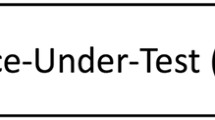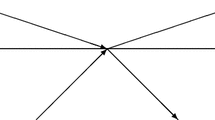Abstract
We characterize and discuss the identifiability condition for quantum process tomography, as well as the minimal experimental resources that ensure a unique solution in the estimation of quantum channels, with both direct and convex optimization methods. A convenient parametrization of the constrained set is used to develop a globally converging Newton-type algorithm that ensures a physically admissible solution to the problem. Numerical simulation is provided to support the results and indicate that the minimal experimental setting is sufficient to guarantee good estimates.



Similar content being viewed by others
Notes
These topics could also be studied from an abstract, frame-theoretical viewpoint [14]: however, in order to maintain contact with well-established notations and concepts in quantum information theory, we choose a more direct approach.
If the optimization is constrained to \(\mathcal{A}_+\cap \mathcal{I},\) we are guaranteed that \(f_{jk}\) will tend to be positive for a sufficiently large numbers of trials.
References
Aiello, A., Puentes, G., Voigt, D., Woerdman, J.P.: Maximum-likelihood estimation of Mueller matrices. Opt. Lett. 31(6), 817–819 (2006)
Alicki, R., Lendi, K.: Quantum Dynamical Semigroups and Applications. Springer, Berlin (1987)
Altafini, C.: Feedback stabilization of isospectral control systems on complex flag manifolds: application to quantum ensembles. IEEE Trans. Autom. Control 11(52), 2019–2028 (2007)
Altafini, C., Ticozzi, F.: Modeling and control of quantum systems: an introduction. IEEE Trans. Autom. Control 57(8), 1898–1917 (2012)
Belavkin, V.P.: Towards the theory of control in observable quantum systems. Autom. Remote Control 44, 178–188 (1983)
Benenti, G., Strini, G.: Simple representation of quantum process tomography. Phys. Rev. A 80(2), 022–318 (2009)
Bhatia, R.: Matrix Analysis. Springer, New York (1997)
Bisio, A., Chiribella, G., D’Ariano, G.M., Facchini, S., Perinotti, P.: Optimal quantum tomography of states, measurements, and transformations. Phys. Rev. Lett. 102, 010,404 (2009)
Bongioanni, I., Sansoni, L., Sciarrino, F., Vallone, G.: Experimental quantum process tomography of non-trace-preserving maps. Phys. Rev. A 82(4), 042–307 (2010)
Boulant, N., Havel, T.F., Pravia, M.A., Cory, D.G.: Robust method for estimating the Lindblad operators of a dissipative quantum process from measurements of the density operator at multiple time points. Phys. Rev. A 67(4), 042–322 (2003)
Bouwmeester, D., Ekert, A., Zeilinger, A. (eds.): The Physics of Quantum Information: Quantum Cryptography, Quantum Teleportation, Quantum Computation. Springer, Berlin (2000)
Boyd, S., Vandenberghe, L.: Convex Optimization. Cambridge University Press, Cambridge (2004)
Busch, P.: Informationally complete sets of physical quantities. Int. J. Theor. Phys. 30(9), 1217–1227 (1991)
Casazza, P.: The art of frame theory. Taiwan. J. Math. 4(2), 129–201 (2000)
Choi, M.D.: Completely positive linear maps on complex matrices. Linear Algebra Appl. 10, 285–290 (1975)
Cover, T.M., Thomas, J.A.: Elements of Information Theory. Wiley, New York (1991)
Dahleh, M., Pierce, A., Rabitz, H., Pierce, A.: Control of molecular motion. Proc. IEEE 84, 6–15 (1996)
D’Alessandro, D.: Introduction to Quantum Control and Dynamics. Applied Mathematics & Nonlinear Science. Chapman & Hall/CRC, London (2007)
D’Alessandro, D., Dahleh, M.: Optimal control of two level quantum system. IEEE Trans. Autom. Control 46(6), 866–876 (2001)
D’Ariano, G.M., Lo Presti, P.: Quantum tomography for measuring experimentally the matrix elements of an arbitrary quantum operation. Phys. Rev. Lett. 86, 4195–4198 (2001)
D’Ariano, G.M., Maccone, L., Paris, M.G.A.: Quorum of observables for universal quantum estimation. J. Phys. A Math. Gen. 34(1), 93 (2001)
Doherty, A., Doyle, J., Mabuchi, H., Jacobs, K., Habib, S.: Robust control in the quantum domain. Proc. IEEE Conf. Decis. Control 1, 949–954 (2000)
Fiurášek, J., Hradil, Z.: Maximum-likelihood estimation of quantum processes. Phys. Rev. A 63(2), 020–101 (2001). doi:10.1103/PhysRevA.63.020101
Holevo, A.: Statistical Structure of Quantum Theory. Lecture Notes in Physics; Monographs, vol. 67. Springer, Berlin (2001)
Horn, R.A., Johnson, C.R.: Matrix Analysis. Cambridge University Press, New York (1990)
James, D.F.V., Kwiat, P.G., Munro, W.J., White, A.G.: Measurement of qubits. Phys. Rev. A 64, 052–312 (2001)
James, M., Nurdin, H., Petersen, I.: \({H}^{\infty }\) control of linear quantum stochastic systems. IEEE Trans. Autom. Control 53(8), 1787–1803 (2008)
Khaneja, N., Brockett, R., Glaser, S.: Time optimal control of spin systems. Phys. Rev. A 63, 032–308 (2001)
Kosmol, P.: Optimierung und Approximation. de Gruyter, Berlin (1991)
Kraus, K.: States, Effects, and Operations: Fundamental Notions of Quantum Theory. Lecture notes in Physics. Springer, Berlin (1983)
Mohseni, M., Rezakhani, A.T., Lidar, D.A.: Quantum-process tomography: resource analysis of different strategies. Phys. Rev. A 77(3), 032,322 (2008)
Nielsen, M.A., Chuang, I.L.: Quantum Computation and Information. Cambridge University Press, Cambridge (2002)
Nurdin, H., James, M., Petersen, I.: Coherent quantum LQG control. Automatica 45, 1837–1846 (2009)
Paris, M.G.A., R̆ehác̆ek, J. (eds.): Quantum States Estimation, Lecture Notes Physics, vol. 649. Springer, Berlin (2004)
Petz, D.: Quantum Information Theory and Quantum Statistics. Springer, Berlin (2008)
R̆ehác̆ek, J., Englert, B.G., Kaszlikowski, D.: Minimal qubit tomography. Phys. Rev. A 70(5), 052,321 (2004)
Sacchi, M.F.: Maximum-likelihood reconstruction of completely positive maps. Phys. Rev. A 63(5), 054–104 (2001). doi:10.1103/PhysRevA.63.054104
Scott, A.J.: Optimizing quantum process tomography with unitary 2-designs. J. Phys. A Math. Theor. 41, 055–308 (2008)
Ticozzi, F., Nishio, K., Altafini, C.: Stabilization of stochastic quantum dynamics via open- and closed-loop control. IEEE Trans. Autom. Control 58(1), 74–85
Ticozzi, F., Viola, L.: Analysis and synthesis of attractive quantum Markovian dynamics. Automatica 45, 2002–2009 (2009)
van Handel, R., Stockton, J.K., Mabuchi, H.: Feedback control of quantum state reduction. IEEE Trans. Autom. Control 50(6), 768–780 (2005)
Villoresi, P., Jennewein, T., Tamburini, F., M. Aspelmeyer, C.B., Ursin, R., Pernechele, C., Luceri, V., Bianco, G., Zeilinger, A., Barbieri, C.: Experimental verification of the feasibility of a quantum channel between space and earth. New J. Phys. 10, 033,038 (2008)
Wiseman, H.M., Milburn, G.J.: Quantum Measurement and Control. Cambridge University Press, Cambridge, MA (2009)
Ziman, M.: Incomplete quantum process tomography and principle of maximal entropy. Phys. Rev. A 78, 032–118 (2008)
Ziman, M., Plesch, M., Bužek, V., Štelmachovič, P.: Process reconstruction: From unphysical to physical maps via maximum likelihood. Phys. Rev. A 72(2), 022–106 (2005)
Acknowledgments
The authors would like to thank Alberto Dall’Arche, Andrea Tomaello, Prof. Paolo Villoresi and Dr. Giuseppe Vallone for stimulating discussions on the topics of this paper. Work partially supported by the QFuture research grant of the University of Padova, and by the Department of Information Engineering research project “QUINTET.”
Author information
Authors and Affiliations
Corresponding author
Appendix: global convergence of the Newton algorithm
Appendix: global convergence of the Newton algorithm
Let us consider the identification problem in (20) with the ML functional (24). To prove the convergence of the corresponding Newton algorithm, we need of the following result.
Proposition 5
Consider a function \(f: X \subset \mathbb {R}^n\rightarrow \mathbb {R}\) twice differentiable on \(X\) with \(H_x\) the Hessian of \(f\) at \(x\). Suppose moreover that \(f\) is strongly convex on a set \(D\subset X\), i.e., there exists a constant \(m> 0\) such that \(H_x\ge mI\) for \(x\in D \), and \(H_x\) is Lipschitz continuous on \( D \). Let \(\{x_i\}\in D\) be the sequence generated by the Newton algorithm. Under these assumptions, Newton’s algorithm with backtracking converges globally. More specifically, \(\{x_i\}\) decreases in linear way for a finite number of steps and converges in a quadratic way to the minimum point after the linear stage.
Proof
See [12, 9.5.3, p. 488]. \(\square \)
We proceed in the following way: Identify a compact set \(D\) such that \(\underline{\theta }_l \in D\) and prove that the Hessian is coercive and Lipschitz continuous on \(D\). We then apply Proposition A.1 in order to prove the convergence
Since \(\underline{\theta }_0\in \hbox {int} \left( \mathcal {C} \right) \) we consider the set
The presence of the backtracking stage in the algorithm guarantees that the sequence \(G_q(\underline{\theta }_0),G_q(\underline{\theta }_1), \ldots \) is decreasing. Thus, \(\underline{\theta }_l\in D,\,\forall l\ge 0\).
Proposition 6
The following facts hold:
-
1.
\(D\) is a compact set.
-
2.
\(H_{\underline{\theta }}\) is coercive and bounded on \(D\), namely there exist \(s,S>0\) such that
$$\begin{aligned} sI\le H_{\underline{\theta }} \le \hbox {SI} \quad \forall \; \underline{\theta }\in D. \end{aligned}$$(39) -
3.
\( H_{\underline{\theta }}\) is Lipschitz continuous on \(D\).
Proof
(1) \(D\) is contained into the bounded set \(\mathcal {C}\). Since \(D\) is a finite-dimensional space, it is sufficient to show that
Here, we have three kind of boundary: \( \partial \mathcal {I}\cap \hbox {int} \left( A_+ \right) ,\; \hbox {int} \left( \mathcal {I} \right) \cap \partial A_+\) and \( \partial \mathcal {I}\cap \partial A_+\). Notice that, \(\log \det (\chi (\underline{\theta }))\) takes finite values on \(\partial \mathcal {J}\cap \hbox {int} \left( A_+ \right) \). Accordingly, taking (21) into account,
Then, \(\hbox {int} \left( \mathcal {I} \right) \cap \partial A_+\) is the set of \(\underline{\theta }\) for which \(J\) is bounded and there exists at least one eigenvalue of \(\chi (\underline{\theta })\) equal to zero. Thus,
Finally, from (41) and (42) it follows that \(G_q(\underline{\theta })\) diverges as \(\underline{\theta }\) approach \(\partial \mathcal {I}\cap \partial A_+\).
(2) First, observe that \(D\subset \hbox {int} \left( \mathcal {C} \right) \). Since \(D\) is a compact set, there exists \(s>0\) such that \( \chi (\underline{\theta })^{-1}\ge sI \;\; \forall \; \underline{\theta }\in D\). Define
where \(M_{jk}\) is a positive semidefinite matrix with rank equal to one. Accordingly, the Hessian of the functional in (24) is
Since \(\{Q_l\}_{l=1}^{12}\) are orthonormal matrices and \(\delta _{jk} M_{jk}\ge 0\), we have that
Notice that, \(H_{\underline{\theta }}\) is continuous on \(\hbox {int} \left( \mathcal {C} \right) \). Since \(D \subset \hbox {int} \left( \mathcal {C} \right) \), it follows that \(H_{\underline{\theta }}\) is continuous on the compact \(D\). Hence, there exists \(S>0\) such that \(H_{\underline{\theta }} \le SI\,\forall \; \underline{\theta }\in D\). We conclude that \( H_{\underline{\theta }}\) is coercive and bounded on \(D\).
(3) \(H_{\underline{\theta }}\) is continuous on \(D\) and \( \Vert H_{\underline{\theta }} \Vert \le S\,\forall \; \underline{\theta }\in D\), therefore \(H_{\underline{\theta }}\) is Lipschitz continuous on \(D\). \(\square \)
Since all the hypothesis of the Proposition A.1 are satisfied, we have the following proposition.
Proposition 7
The sequence \(\{\underline{\theta }_l\}_{l\ge 0}\) generated by the Newton algorithm of Section 4.3 converges to the unique minimum point \(\hat{\underline{\theta }}^q\in \hbox {int} \left( \mathcal {C} \right) \) of \(G_q\).
Rights and permissions
About this article
Cite this article
Zorzi, M., Ticozzi, F. & Ferrante, A. Minimal resources identifiability and estimation of quantum channels. Quantum Inf Process 13, 683–707 (2014). https://doi.org/10.1007/s11128-013-0682-x
Received:
Accepted:
Published:
Issue Date:
DOI: https://doi.org/10.1007/s11128-013-0682-x




